the place where Paleontology and Paleoanthropology meets Philately
Gambia
Dinosaurs and other prehistoric animals, Charles Darwin on stamps and postmarks of Gambia
| << previous country | back to index | next country >> |
Contents:
- Country overview
- Philately of Gambia
- Official stamps of Gambia related to Paleontology
- Other stamps of Gambia to consider
- Commemorative postmarks of Gambia related to Paleontology
- References
- Acknowledgements
The Gambia officially the Islamic Republic of The Gambia, is a country in West Africa mostly surrounded by Senegal with a short strip of its coastline bordered with the Atlantic Ocean at its western end. It is the smallest country on mainland Africa. The Gambia is situated on either side of the Gambia River, the nation's namesake, which flows through the centre of the Gambia and empties into the Atlantic Ocean. Its area is 10,689 square kilometres with a population of about 1,800,000. Banjul is the Gambian capital, and the largest cities are Serekunda and Brikama. [R1]
According to Michel catalogue, until the mid-1980s, the Post of Gambia issued no more than 20 stamps per year. Later on to the present, Gambia has rapidly increased the number of stamps issued per year.
In 1992, Gambia issued its first dinosaur stamps – that same year they published 160 different stamps. The following year, they published 353 stamps!
Poor countries like Gambia print stamps for the purpose to sell them to stamp collectors instead of for domestic use to mail letters and packages. In the last few decades, most of the stamps published have little to do with local history or culture. [R2]
Official stamps of Gambia related to Paleontology: dinosaurs and other prehistoric animals
| 21.09.1992 "Prehistoric animals" | 06.02.1995 "Prehistoric animals" | 23.06.1997 "Dinosaurs" |
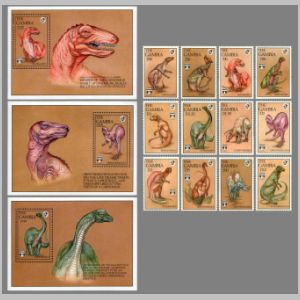 |
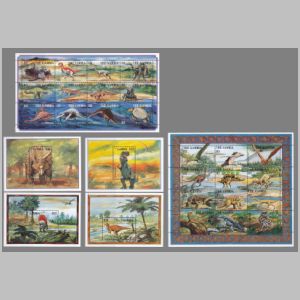 |
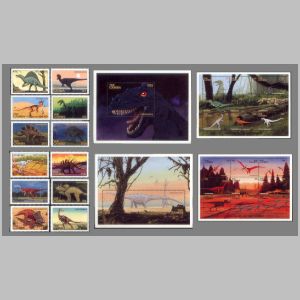 |
| 01.08.1999 "Prehistoric animals" | 01.08.2003 "Prehistoric animals" | 24.02.2010 "200th anniversary of Charles Darwin" |
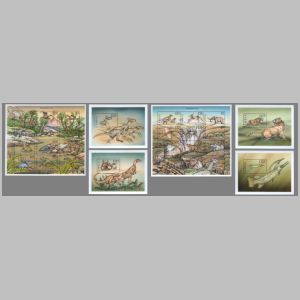 |
 |
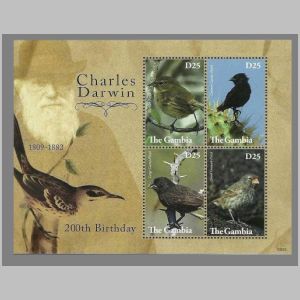 |
| 15.09.2014 "Dinosaurs" | ||
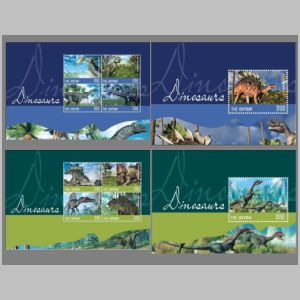 |

|
|
Other stamps to consider: living fossil Latimeria chalumnae, HMS Beagle
| 12.02.1997 "Endangered Species" [A1] | 15.10.1998 "Ships" [A2] | |
 |
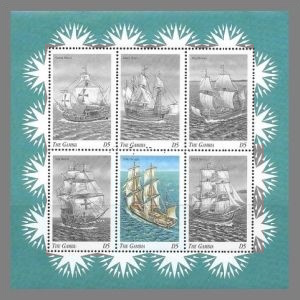 |
|
Notes:
[A1] Latimeria chalumnae (stamp Nr. 11 on the sheet) among Endangered Species on stamps of Gambia 1997.
On 20 February 1939, the stunning announcement was made that a Coelacanth (Latimeria) had been caught off the Chalumna River mouth near East London (a city in RSA). At that time, the Coelacanth was thought to be extinct for nearly 70 million years. The drama commenced on 22 December 1938, when Capt H Goosen, skipper of the trawler Nenrine, brought ashore a peculiar metallic-blue, heavily-scaled fish with fins resembling legs. Miss Marjorie Courtenay-Latimer, Curator o the East London Museum, was informed of the strange catch, but was unable to identify the fish, which measured 1,5 m in length and weighed 57 kg. "Searching for African Coelacanths" exhibit of Susan Bahnick Jones explain the story of the "leaving fossil" discovery. [R4]
[A2] HMS Beagle (stamp Nr. 5 on the sheet) among other ships on stamps of Gambia 1998. HMS Beagle was a Cherokee-class 10-gun brig-sloop of the Royal Navy, one of more than 100 ships of this class. On the second voyage a young naturalist named Charles Darwin was on board; the pivotal role this round the world voyage played in forming his scientific theories made Beagle one of the most famous ships in history. Darwin had kept a diary of his experiences, and rewrote this as the book titled Journal and Remarks, published in 1839 as the third volume of the official account of the expedition. This travelogue and scientific journal was widely popular, and was reprinted many times with various titles, becoming known as The Voyage of the Beagle. This diary is where Darwin drew most of the ideas for his publications. Darwin attributes his first real training in natural history to his voyage on the Beagle. [R3]
Commemorative post marks of Gambia related to Paleontology: dinosaurs and other prehistoric animals
| 21.09.1992 "Prehistoric animals" [FDC] [C1] | ||
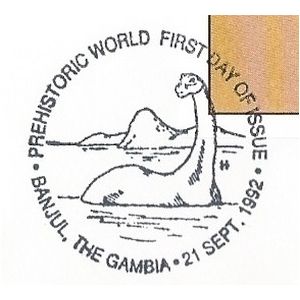 |
|
|
Notes:
[C1] - the only commemorative postmark used on FDC with stamps of prehistoric animals. FDC of all other issues canceled with regular/date postmark. Example is here.
References:
- [R1] Gambia: Wikipedia WikiTravel FlagCounter
- [R2] Postal History and Philately of Gambia:
Wikipedia
Links to official website of the Post Authority, stamp catalog and a list of new stamps of Gambia are here - [R3] HMS Beagle: Wikipedia
- [R4] Latimeria: Wikipedia, Encyclopaedia Britanica
Acknowledgement:
Dr. Peter Voice from Department of Geological and Environmental Sciences, Western Michigan University, for the draft page review and his valuable comments.
| << previous country | back to index | next country >> |